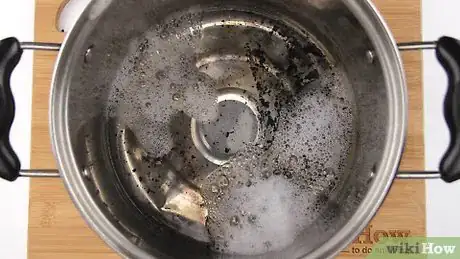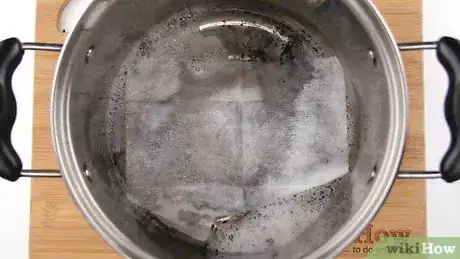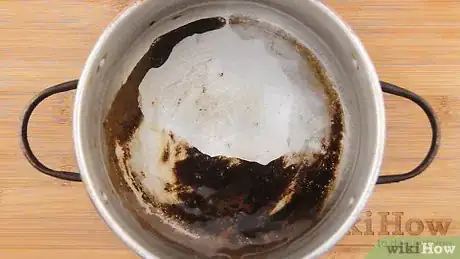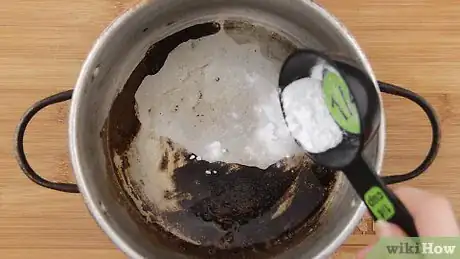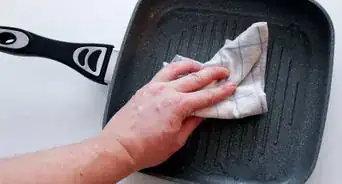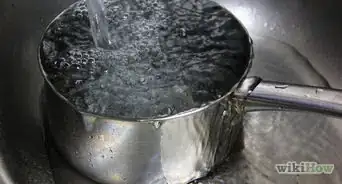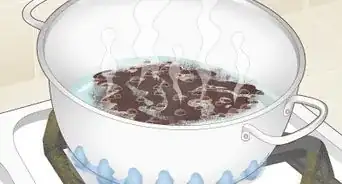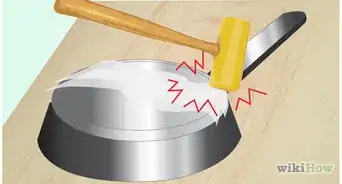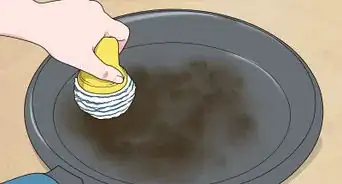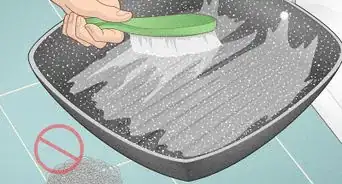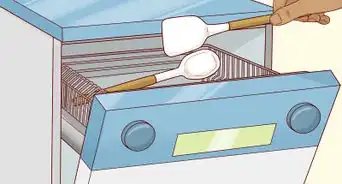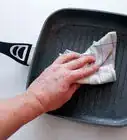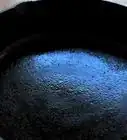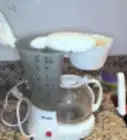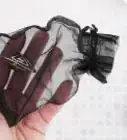This article was co-authored by Susan Stocker. Susan Stocker runs and owns Susan’s Green Cleaning, the #1 Green Cleaning Company in Seattle. She is well known in the region for outstanding customer service protocols — winning the 2017 Better Business Torch Award for Ethics & Integrity —and her energetic support of green cleaning practices.
There are 14 references cited in this article, which can be found at the bottom of the page.
This article has been viewed 37,227 times.
Oh no, you've burnt dinner to the bottom of the pot! Now you have a ruined dinner and a stubborn pot to clean up! Never fear, though, you have an arsenal of tips at your disposal, and many of these cleaning methods use what you already have on hand. Between soaking, scrubbing, and deglazing, you should be able to get those burned-on bits off your pan!
Steps
Soaking the Pot
-
1Soak the pot overnight in hot water and soap for an easy clean.[1] Add a dash of soap to the pot and place it in the sink. Run the water in the sink until you get hot water and then fill the pot up completely. Let it sit overnight before attempting to scrub it out in the morning with fresh water and a sponge.[2]
- If you have a tea kettle, you can use boiling water instead of just hot tap water for extra scrubbing power.
-
2Use a dryer sheet to increase the scour-fighting effects of soaking. Squirt dish soap into the pot and set it in the sink to fill it with hot tap water. Submerge a dryer sheet in the pot and leave it to soak for at least an hour. When you get back, remove the dryer sheet and scrub the pot as you normally would.[3]
- You can also leave the dryer sheet in overnight if you prefer, and it will have an even greater effect on the pot.
- Alternatively, try a few dashes of fabric softener in the pan overnight.[4]
Advertisement -
3Try bleach cleansing powder for a quick 30-minute soak. When you take the pan off the stove from cooking, rinse it out and then sprinkle in the cleansing powder. Pour in enough hot water to cover the scorched area and leave it alone to soak for 30 minutes.[5]
- Scrub it down thoroughly with soap and hot water to remove the soap and gunk after 30 minutes.
- Comet and Ajax fall into this category.
Trying Abrasives and Cleaners
-
1Use baking soda, salt, and vinegar to scrub the pot clean. Sprinkle baking soda in the bottom of the pan, enough to mostly coat it. Add a layer of salt on top of that. Finally, sprinkle on white, distilled vinegar and scrub down the pan with steel wool or a sponge to remove tough burned-on spots.[6]
- Bigger salt flakes work better, so use sea salt or kosher salt.
- Don't use this method on nonstick pans.
-
2Try oxalic acid with aluminum foil for stubborn gunk. Once you rinse the pan, add a sprinkle of oxalic acid. Use a wadded-up piece of aluminum foil to scrub the bottom of the pan thoroughly. Rinse it out and then wash it with dishwashing soap and water.[7]
- Don't leave the cleaner on the pan for more than 1 minute or so, as it can damage the pan.
- Don't use this cleaner on coated pans. This cleaner could remove the coating on nonstick pans so use with caution.
-
3Scrub the pan down with a melamine sponge for a non-chemical approach. These sponges work on a microscopic level to scrub away gunk. All you need is the sponge and water, though it wouldn't hurt to add some baking soda. Scrub the pan in circles, moving all around it as you go, and the eraser will take up most or all of the burnt-on gunk.[8]
Using Boiling and Deglazing Methods
-
1Boil plain water in the pot if you don't have special cleaners. Add enough water to cover the scorched area and set the pot on the stove. Bring the pot to a boil and let it boil for 5-10 minutes. Once it's done, take it off the stove and pour out the water. Scrub the pot down with steel wool and soap to take off the burned areas.[11]
-
2Deglaze the pan with water or vinegar to help with large bits. To deglaze the pan, heat it up without anything in it over high heat. It's ready when you drop a small amount of water in it and the water sizzles. Once it's done, pour in enough water or vinegar to coat the bottom of the pan and leave it to cook for a minute or two. Use a plastic spatula to scrape off the burned-on bits, then wash the pan as you normally do.[12]
- This method will produce a lot of steam, so stay back!
- Don't use this method on nonstick pans, as you shouldn't heat them up without anything in them.
-
3Slice lemons in the pan and boil the water for a gentle acid cleaner. Use enough water to cover the 2-3 lemons you cut up in the pan. Place the pot over high heat and let it come to boil. When it boils, let it continue for about 5 minutes, then take the pan off the heat. Scrub the pan down with soap and a scrubbing pad to remove the burnt-on bits.[13]
- You can use any citrus with this method, such as limes, grapefruits, or oranges.
- You don't have the cut the citrus up very much. Slices or quarters is fine.
Using Vinegar and Baking Soda Together
-
1Add enough water and white vinegar to the pot to cover the bottom. Fill the bottom of the pan with just enough water to cover it. Add 1 cup (240 mL) of vinegar to the water in the pot.[14]
- Don't use the good stuff. Just stick to good old white distilled vinegar. It will do the trick.
-
2Bring the water and vinegar to a boil. Set the pan on the stove and turn the burner on high. Let the solution heat up until you see a rolling boil. Let it boil for a few minutes, as you keep an eye on it. Once you see the burnt-on bits starting to come up, take it off the stove.[15]
- This step will get pretty smelly, so be prepared!
-
3Sprinkle in baking soda after pouring out the vinegar. Pour the vinegar/water mixture down the sink. Add enough baking soda into the pan that you lightly coat the bottom of the pan. You'll get a good fizz from this combination so watch out![16]
-
4Scrub the pan thoroughly with a steel wool pad. Use small circles to scrub the pan, applying elbow grease as you do. Go around the pan several times to remove as much of the crud as you can.[17]
- If you need to, you can rinse it out and add a bit more baking soda. In fact, if some areas don't come clean, just mix a little baking soda with water and leave it on the pan for 30 minutes to an hour. When you come back, the stubborn spots should be easy to remove.[18]
-
5Wash the pan with soap and a regular sponge. Once the scoured bits are mostly gone, clean the pot as you usually do. Scrub down the inside with dishwashing detergent and a normal sponge, then rinse it out.[19]
References
- ↑ Susan Stocker. House Cleaning Professional. Expert Interview. 8 November 2019.
- ↑ https://www.thekitchn.com/5-ways-to-clean-a-scorched-pan-252295
- ↑ https://www.womansday.com/home/organizing-cleaning/a51611/this-simple-trick-will-mean-you-never-need-to-scrub-a-pot-or-pan-again/
- ↑ https://www.apartmenttherapy.com/how-to-clean-burnt-pots-scorched-pans-140547
- ↑ https://www.cnet.com/pictures/pan-cleaning-myths-and-what-actually-works/7/
- ↑ https://www.cnet.com/pictures/pan-cleaning-myths-and-what-actually-works/6/
- ↑ https://www.cnet.com/pictures/pan-cleaning-myths-and-what-actually-works/8/
- ↑ https://www.cnet.com/pictures/pan-cleaning-myths-and-what-actually-works/12/
- ↑ https://www.thekitchn.com/5-ways-to-clean-a-scorched-pan-252295
- ↑ Susan Stocker. House Cleaning Professional. Expert Interview. 8 November 2019.
- ↑ https://www.cnet.com/pictures/pan-cleaning-myths-and-what-actually-works/2/
- ↑ https://www.thekitchn.com/5-ways-to-clean-a-scorched-pan-252295
- ↑ https://www.southernliving.com/grains/rice/how-to-clean-burnt-pan-rice
- ↑ https://www.apartmenttherapy.com/how-to-clean-burnt-pots-scorched-pans-140547
- ↑ https://www.southernliving.com/grains/rice/how-to-clean-burnt-pan-rice
- ↑ https://www.apartmenttherapy.com/how-to-clean-burnt-pots-scorched-pans-140547
- ↑ https://www.southernliving.com/grains/rice/how-to-clean-burnt-pan-rice
- ↑ https://www.apartmenttherapy.com/how-to-clean-burnt-pots-scorched-pans-140547
- ↑ https://www.southernliving.com/grains/rice/how-to-clean-burnt-pan-rice
About This Article
One way to clean burnt-on food from the bottom of a scorched pot is by filling it with hot water and letting it sit overnight before scrubbing the gunk with a sponge. To boost the soaking power, add a squirt of dish soap and submerge a dryer sheet in the hot water. If soaking doesn’t make it any easier to get your pot clean, you can maximize your scrubbing power with abrasives. After rinsing your pot, sprinkle a layer of baking soda on the bottom, then add a layer of salt before pouring in a little bit of distilled vinegar. With everything in the pot, use some elbow grease and steel wool to remove the burned-on spots. However, make sure to avoid using abrasives on non-stick pans, since they will ruin the coating. For more help, including how to get rid of burnt gunk with boiling water, read on!
